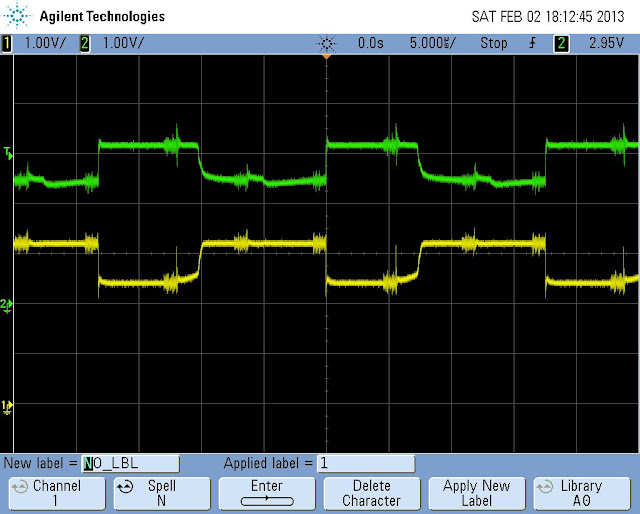Just a quick status update on the progress of the cube since my last post.
On the hardware side there has been activity on two different topics. At first I had the opportunity to analyze my circuit and try to find out what’s causing the ghosting effect at higher framerates using a friends oscilloscope. This involved getting comfortable with the usage and application of an oscilloscope in general and then trying to find out the different effects of different measurements and several different wiring variants of the transistors on the board.
| From LED Cube Images |
| From LED Cube Images |
This took a good part of a Saturdays afternoon and in the end I was pretty confident that the cause of my problem is that the base of the PNP transistor is not recovering fast enough to the blocking voltage as the IC leaves the pin floating after disconnecting it from GND. Attempts to remedy this with pull-up resistors allowed me to increase the refresh rate of the cube about 10x up to ~1kHz without noticeable ghosting but that’s not really sufficient for my taste. My target is to allow up to 50kHz refresh rate on the 3x3x3 cube without noticeable afterglow of the LEDs. On the internet I found several topics where similar problems are discussed and all of them seem to have a common solution: add a Schottky diode to bring up the base voltage level faster. I had no schottky readily available so I unsoldered one from an old PC motherboard and used it to cover one of the three LED layers on the breadboard. Results are promising so far, I hope this still works when all three layers are equiped with a schottky. For now I think I can manage to work with lower cube refresh-rates until I’m able to pick up correctly dimensioned schottkys for all three layers. Until then this will be the situation on a single transistor at 5kHz (Yellow: base current; Green: collector current):
 |
| From LED Cube Images |
Update: Short explaination to this graph. It was measured by hooking the oscilloscope to the base and collector of one layer PNP transistor. Pull-Ups are in place. Clearly visible (by the “knobs”) are the layer switches causing some disturbance each time. When the layer gets activated the transistor instantly switches to conducting mode. But when it is disconnected again, it requires about half of the next layers visible time (~2us) to completely go into non-conducting state again. The faster the refresh-rate the longer the afterglow in each layer…
The last few days I’ve also been tingerking and thinking of how I could build the cube skelleton. I found no practical way to solder the LEDs together in a stable manner without adding additional wire. So yesterday I purchased a bit of iron wire and tried to solder the first layer. I drilled a few holes in a wooden plate, put the LEDs in it and soldered the LED pins together where possible.
| From LED Cube Images |
Next I prepared the iron wire, straightened it, cut out the parts…
| From LED Cube Images |
… prepared them for being soldered together with the LEDs to build the first layer…
| From Building LED Cube |
… and failed miserably, because the solder did not stick to the iron wire
| From Building LED Cube |
And I have absolutely no idea currently, what went wrong. Obviously another gap in soldering knowledge which I have to close when I want my next attempt for creating the LED grid to be successful.
At least on the software side there has been much more progress and success. I created a Github project for the LED cube driver software and improved and refactored the whole code several times now. So far I’m pretty confident that I created a quite flexible architecture and codebase so that it should be scalable for the 8x8x8 cube with minimal effort. Furthermore the animation framework is pretty stable and capable enough that I was able to create a new animation from scratch (one where you can move the bright LED using the cursor keys) within ten minutes. Each animation is encapsulated in a single class and completely independent from the cubes real refresh-rate. Notable features of my code which are finished (for now):
- smooth BAM (Bit Angle Modulation) for controlling the brightness of single LEDs
- console status output and …
- … keyboard control for the animations, I/O via ncurses library
- flexible animation architecture, independent from cube refresh rate
- stable timing framework for controlling animation and cube refresh rates
- a small set of prototype animations (whole cube pulsating, a single linear moving light, single random LEDs pulsating, a keyboard-controllable light)